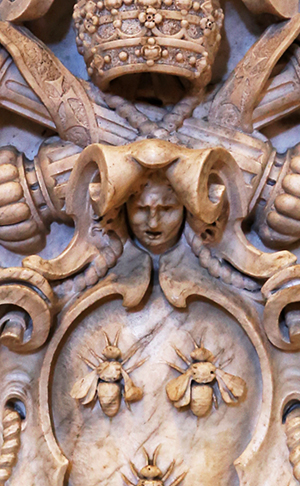A Happy Ending for Urban VIII’s Pregnant Niece
In St. Peter’s Basilica, 17th-century sculptors left a mystery with an intriguing possible backstory.


But have you looked closely at those four towering columns? Modeled after the columns in Solomon’s temple, they celebrate the papacy of Pope Urban VIII, the pope who led the Church from 1623 until his death in 1644. At the base of each column is a large marble pedestal, called a “plinth,” on which are carved Pope Urban’s coat of arms. There, criss-crossed, are the Keys of the Kingdom, symbol of the papacy. There are laurel leaves and bees — in fact, throughout St. Peter’s Basilica, there are bees which symbolize the Barberini family, Pope Urban’s family of origin. And climbing among the twisted trails on the columns are lizards, slim, sleek creatures who can shed a tail if caught, then regrow a new tail — an allegorical reference to the Resurrection of Christ.
And there, at the four corners of the great papal altar, the artist Bernini and his assistants left a story. Starting at the southeast corner, then progressing clockwise around to the northeast corner, is a woman in labor. At first, on the southeast corner, she seems to be at peace; but her pain grows greater as you turn the corner, and the woman grimaces. Her expression grows more and more distressed until, on the eighth and final surface (on the northeast corner), there’s the baby — a happy, curly-haired cherub! Nineteenth-century French physician and historian Gustave Joseph Witkowski, in his L’art profane à l’église (Secular Art in the Church), wrote:
The scene begins on the face of the left-hand front plinth; the woman’s face begins to contract; on the second and following plinths the features pass through a series of increasingly violent convulsions. Simultaneously, the hair becomes increasingly disheveled; the eyes, which at first express a bearable degree of suffering, take on a haggard look; the mouth, closed at first, opens, then screams with piercing realism. … Finally, comes the delivery: the belly subsides and the mother’s head disappears, to give way to a cherubic baby’s head with curly hair, smiling beneath the unchanging pontifical insignia.
According to one popular interpretation, the pregnant woman is Pope Urban’s beloved niece. She was undergoing a difficult pregnancy, the story goes, and Urban VIII pledged that if God would help her and she delivered a healthy baby, then the pope would dedicate an altar in St. Peter’s.
- Keywords:
- art
- pope urban viii
















